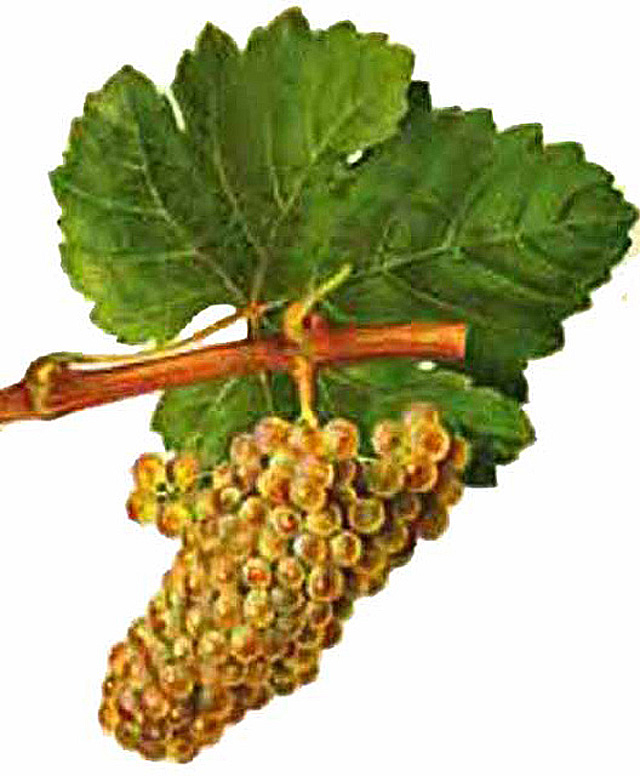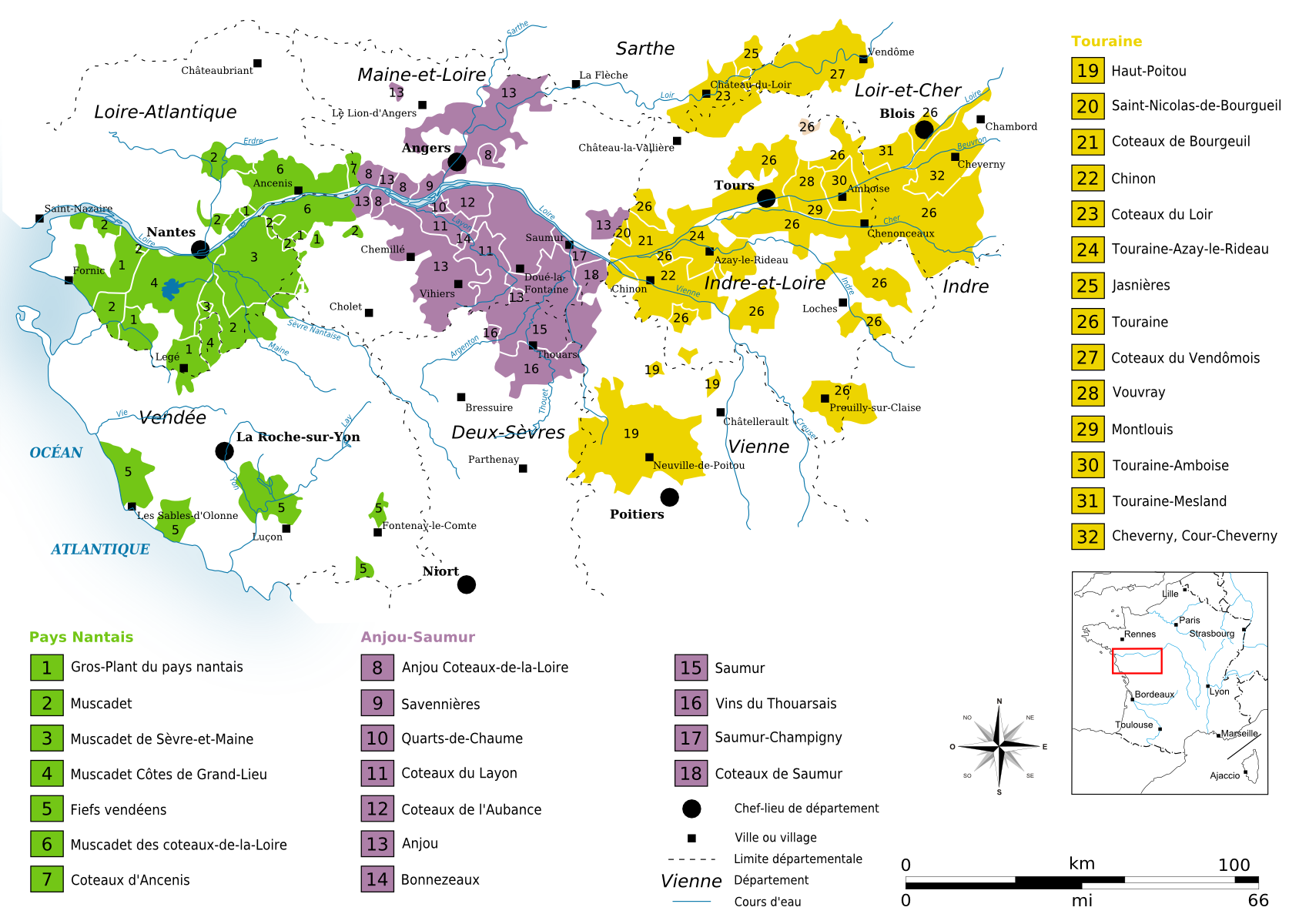|
Meslier-Saint-François
Meslier-Saint-François is a white French wine grape variety that is now grown predominantly in the Loir-et-Cher department of the Loire Valley (wine), Loire Valley. Historically, the grape was found more widely throughout the Loire and western France and was even used in the production of Armagnac (drink), Armagnac. However, for most of the 20th century Meslier-Saint-François has been following a similar route to the Loire grape Arbois (grape), Arbois with plantings rapidly declining.J. Robinson ''Jancis Robinson's Guide to Wine Grapes'' pg 109 Oxford University Press 1996 The grape is a crossing (plant), crossing of Gouais blanc and Chenin blanc making it a sibling of Balzac blanc and Colombard.J. Robinson, J. Harding and J. Vouillamoz ''Wine Grapes - A complete guide to 1,368 vine varieties, including their origins and flavours'' pg 82, Allen Lane 2012 Synonyms Various synonyms have been used to describe Meslier-Saint-François and its wines, including Anereau, Annereau, Bl ... [...More Info...] [...Related Items...] OR: [Wikipedia] [Google] [Baidu] |
Colombard
Colombard (also known as French Colombard in North America) is a white French wine grape variety that is the offspring of Chenin blanc and Gouais blanc.winepros.com.au. This makes the grape the sibling of the Armagnac Meslier-Saint-François and the nearly extinct Cognac grape Balzac blanc.J. Robinson, J. Harding and J. Vouillamoz ''Wine Grapes - A complete guide to 1,368 vine varieties, including their origins and flavours'' pg 82, Allen Lane 2012 In France, it was traditionally grown in the Charentes and Gascony for distilling into Cognac and Armagnac respectively. Today it is still among the permitted white grape varieties in Bordeaux wine, and in Gascony for Vins de Pays Côtes de Gascogne and the white Floc de Gascogne.Maison des Producteurs du Floc de Gascogne, F-32 800 Eauze aperitif drink. The wine is known for its distinctive flavours of Guava. Old vine grapes are crushed by some northern Californian producers and made into a fruity white wine of interesting c ... [...More Info...] [...Related Items...] OR: [Wikipedia] [Google] [Baidu] |
Balzac Blanc
Balzac blanc is a white French wine grape variety that is grown in the Charente and Charente-Maritime regions of Southwest France (wine), Southwest France where it was once used for Cognac production but now is nearly extinct. The grape was one thought to be a color mutation of Mourvèdre (known as Monastrell and Balzac noir) but DNA analysis in 2000 showed that the two grapes were distinct and that Balzac blanc was a crossing (plant), crossing of Gouais blanc and Chenin blanc.J. Robinson, J. Harding and J. Vouillamoz ''Wine Grapes - A complete guide to 1,368 vine varieties, including their origins and flavours'' pg 82, Allen Lane 2012 History Ampelographers believe that the grape originated in the Cognac-producing wine region of the Charente and may be named after the commune of Balzac, Charente. The first written mention of Balzac blanc was by in 1842 when it was listed as one of the grape varieties growing around La Rochelle in the nearby Charente-Maritime department. It was be ... [...More Info...] [...Related Items...] OR: [Wikipedia] [Google] [Baidu] |
French Wine
French wine is produced all throughout France, in quantities between 50 and 60 million hectolitres per year, or 7–8 billion bottles. France is one of the largest wine producers in the world, along with Italian, Spanish, and American wine-producing regions. French wine traces its history to the 6th century BCE, with many of France's regions dating their wine-making history to Roman times. The wines produced range from expensive wines sold internationally to modest wines usually only seen within France such as the Margnat wines of the post war period. Two concepts central to the better French wines are the notion of '' terroir'', which links the style of the wines to the locations where the grapes are grown and the wine is made, and the ''Appellation d'origine contrôlée'' (AOC) system, replaced by the Appellation d'Origine Protégée (AOP) system in 2012. Appellation rules closely define which grape varieties and winemaking practices are approved for classificat ... [...More Info...] [...Related Items...] OR: [Wikipedia] [Google] [Baidu] |
Grape Variety
This list of grape varieties includes cultivated grapes, whether used for wine, or eating as a table grape, fresh or dried (raisin, currant, sultana). For a complete list of all grape species including those unimportant to agriculture, see Vitis. The term ''grape variety'' refers to cultivars rather than actual botanical varieties according to the International Code of Nomenclature for Cultivated Plants, because they are propagated by cuttings and may have unstable reproductive properties. However, the term ''variety'' has become so entrenched in viticulture that any change to using the term ''cultivar'' instead is unlikely. Single species grapes While some of the grapes in this list are hybrids, they are hybridized within a single species. For those grapes hybridized across species, known as interspecific hybrids, see the section on multispecies hybrid grapes below. ''Vitis vinifera'' (wine) Red grapes White grapes Rose Grapes ''Vitis vinifera'' (table) ... [...More Info...] [...Related Items...] OR: [Wikipedia] [Google] [Baidu] |
Loir-et-Cher
Loir-et-Cher (, ) is a department in the Centre-Val de Loire region of France. Its name is originated from two rivers which cross it, the Loir in its northern part and the Cher in its southern part. Its prefecture is Blois. The INSEE and La Poste gave it the number 41. It had a population of 329,470 in 2019.Populations légales 2019: 41 Loir-et-Cher INSEE History The department of Loir-et-Cher covers a territory which had a substantial population during the prehistoric period. However it was not until the that local inhabitants built various castles and other fortifications to enable them to withstand a series of invasions of |
Loire Valley (wine)
The Loire Valley wine region includes the French wine regions situated along the river Loire from the Muscadet region near the city of Nantes on the Atlantic coast to the region of Sancerre and Pouilly-Fumé just southeast of the city of Orléans in north central France. In between are the regions of Anjou wine, Saumur, Bourgueil, Chinon, and Vouvray. The Loire Valley itself follows the river through the Loire department to the river's origins in the Cévennes but the majority of the wine production takes place in the regions noted above. The area includes 87 appellations under the ''Appellation d'origine contrôlée'' (AOC), '' Vin Délimité de Qualité Superieure'' (VDQS) and '' Vin de pays'' systems. While the majority of production is white wine from the Chenin blanc, Sauvignon blanc and Melon de Bourgogne grapes, there are red wines made (especially around the Chinon region) from Cabernet franc. In addition to still wines, rosé, sparkling and dessert wines are also pro ... [...More Info...] [...Related Items...] OR: [Wikipedia] [Google] [Baidu] |
Armagnac (drink)
Armagnac (, ) is a distinctive kind of brandy produced in the Armagnac region in Gascony, southwest France. It is distilled from wine usually made from a blend of grapes including Baco 22A, Colombard, Folle blanche and Ugni blanc, traditionally using column stills rather than the pot stills used in the production of cognac, which is made predominantly from ugni blanc grapes. The resulting spirit is then aged in oak barrels before release. Production is overseen by the Institut national de l'origine et de la qualité (INAO) and the Bureau National Interprofessionel de l'Armagnac (BNIA). Armagnac was one of the first areas in France to begin distilling spirits, but the overall volume of production is far smaller than cognac production and therefore is less known outside Europe. In addition, it is for the most part made and sold by small producers, whereas cognac production is dominated by big-name brands, especially Courvoisier (owned by Beam Suntory), Hennessy ( LVMH), Ma ... [...More Info...] [...Related Items...] OR: [Wikipedia] [Google] [Baidu] |
Arbois (grape)
Arbois or Arbois Blanc is a white French wine grape variety planted primarily in the Loire regions. J. Robinson ''Jancis Robinson's Wine Course'' Third Edition pg 100 Abbeville Press 2003 Despite being a minor grape, in the late 20th century it was the third most widely planted grape variety in the Loir-et-Cher ''département'' which includes the winemaking areas of Cheverny, Cour-Cheverny, Montrichard, Oisly, Saint-Romain-sur-Cher, Valençay as well as vineyards that make wines under the Touraine AOC, Cremant de Loire AOC and ''Vin de Pays du Loir et Cher''. By 2004 acreage had steadily declined to around 750 acres (300 hectares). It is still a permitted grape variety in the ''Appellation d'origine contrôlée'' (AOC) regions of Cheverny AOC, Valençay AOC and Vouvray AOC. J. Robinson (ed) ''"The Oxford Companion to Wine"'' Third Edition pg 29 Oxford University Press 2006 T. Stevenson ''"The Sotheby's Wine Encyclopedia"'' pg 210 Dorling Kindersley 2005 History ... [...More Info...] [...Related Items...] OR: [Wikipedia] [Google] [Baidu] |
Crossing (plant)
Plant breeding is the science of changing the traits of plants in order to produce desired characteristics. It has been used to improve the quality of nutrition in products for humans and animals. The goals of plant breeding are to produce crop varieties that boast unique and superior traits for a variety of applications. The most frequently addressed agricultural traits are those related to biotic and abiotic stress tolerance, grain or biomass yield, end-use quality characteristics such as taste or the concentrations of specific biological molecules (proteins, sugars, lipids, vitamins, fibers) and ease of processing (harvesting, milling, baking, malting, blending, etc.). Plant breeding can be performed through many different techniques ranging from simply selecting plants with desirable characteristics for propagation, to methods that make use of knowledge of genetics and chromosomes, to more complex molecular techniques. Genes in a plant are what determine what type of qualit ... [...More Info...] [...Related Items...] OR: [Wikipedia] [Google] [Baidu] |
Gouais Blanc
Gouais blanc () or Weißer Heunisch () is a white grape variety that is seldom grown today but is important as the ancestor of many traditional French and German grape varieties. The name ''Gouais'' derives from the old French adjective ‘gou’, a term of derision befitting its traditional status as the grape of the peasants. Likewise, the German name Weißer Heunisch labels it as one of the lesser " Hunnic" grapes. History Gouais is known to have been widely planted in central and northeastern France in Medieval times. At that time, it was used to produce simple, acidic, white wines, and was primarily grown in unfavourable plots less well-suited for the more highly regarded Pinot noir or Pinot gris. Gouais Blanc was thus the grape of the peasantry rather than of the nobility. Its history before Medieval times is not known with any certainty, but is the subject of much conjecture, similar to many other grape varieties with a long history. Gouais blanc has been proposed as ... [...More Info...] [...Related Items...] OR: [Wikipedia] [Google] [Baidu] |




